Mt.
Gunstock Ski Hoist Inc.
Gilford, NH
Jan 27, 1935-1940
| Many thanks to Phil Cooke, whose father,
Ted Cooke, founded this area in Gilford. It was the first rope tow (or as Cooke
called it, a Ski Hoist) in New Hampshire, and one of the first in New England.
It was also, as far as we can tell, the longest rope tow ever built. At 3100'
long - it was longer than many chairlifts today! There were some early trails on Gunstock
Mountain in the 20's and early 30's, but like all trails at that time, none were
lift served. During the 1933-1934 season, Ted Cooke visited the first rope tow
at Gilbert's Hill in
Vermont, and liked what he saw. He realized that uphill transportation for
skiers was the future.
(Right - A skier rides the ski hoist,
mid 1930's. Courtesy New England Ski
Museum. Click on image for larger version) |
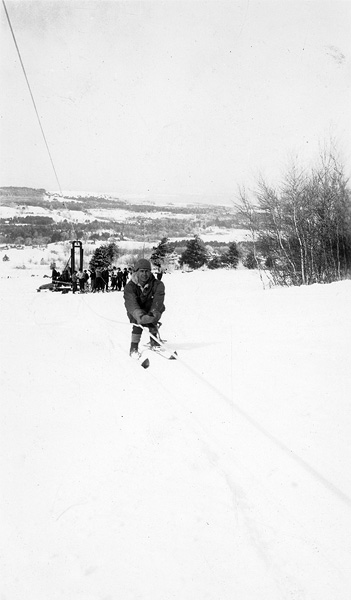 |
|
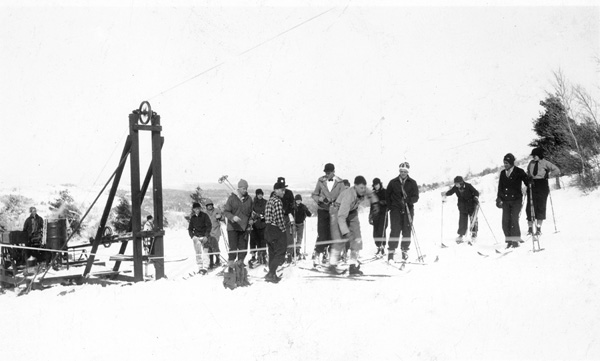 |
Ted decided to open a ski area. He looked
around at several areas, but decided on Gunstock. It was close to Boston, and
had a good profile to build a ski area. Cooke built a 3100' long rope tow in the fall
of 1934. Two trails were cut - Corkscrew and Winnipesaukee. The area opened on
January 27, 1935.
(Left - the base of the ski hoist.
Courtesy New England Ski Museum. Click
on image for larger version)
|
During the first season it became clear that
skiers could simply not hold onto a rope tow for 3100'. It was a fast tow as
well, 20-30mph - imagine trying to hold onto it! So, Cooke decided to come up
with a tow gripper, which he patented in 1937.
In 1938, a single chair opened on the other
side of the hill at Belknap Ski Area. This was a huge development in local
skiing. The Belknap area grew steadily for several years. At some point in the
late 1930's, another rope tow was added for a beginner slope at the Mt. Gunstock
Ski Hoist.
| The last year of operation
was 1939-1940. Below are the statistics for that year:
Winnipesaukee Trail: 3/4 mile long, 30-60
feet wide, 30 degree grade. 1150 feet vertical drop, needs 18" to ski,
expert.
Corkscrew Trail: 3/4 mile long, 20-75 feet wide, 15 degree grade, 900
feet vertical drop. NW Exposure, needs 12" to ski, intermediate.
Both above trails served by 3100 feet long rope tow. Also 800 feet long
rope tow serving a beginner slope which was lighted at night.
On the right is a trail map showing the ski area, on the right. Note the
proximity to the Belknap area. Click on image for larger version.
|
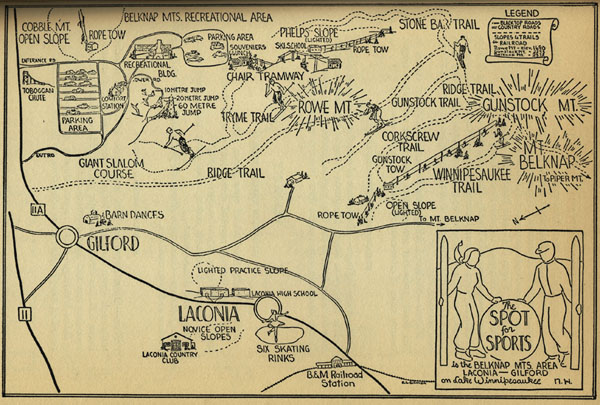
|
Unfortunately, the area closed after the 1939-1940 ski season.
This was due to Ted Cooke's family obligations, along with the competition from the
larger development on the other side of the mountain.
The ski hoist was moved to the
Commonwealth Golf Course,
where it operated for several decades. More information will be added to the
NELSAP Commonwealth page soon.
Today, both trails and the open slope have
grown in tremendously. However, the lift line can still be followed.
Phil Cooke shares
with us some additional information:
The handle was manufactured by the blacksmith
at the family owned stone quarry in Swampscott, MA. It was an ungainly hunk of
metal. Sometimes the handle would not release from the rope at the top. After
going around the bull fly wheel it would fly off in all directions. Someone
could get seriously injured by the flying handle. Fortunately this never
happened. Needless to say the handle was not a commercial success.
The safety switch was an interesting affair. It
was a board located horizontally halfway up the rope tow from the skier exit
point at the top and the fly wheel up on a pole (a telephone pole, actually).
The idea was that if you could not detach yourself from the rope you owuld come
in contact with the safety board which subsequently shut off engine. It was
called the bang board. My father used to say that if you hit the bang board you
may be unconscious but you would be alive.
One of the ski trails was called Winnipesaukee.
I don't remember the names of the other two. One can still make out some of the
trail lines even though the overgrowth is 60 years plus old.
After 5 or 6 years of operating the tow or ski
hoist as my father called it, my mother got tired of my father taking off every
weekend to run the tow. Even though she was a skier she was also bringing up
four children. Therefore the tow was sold to a Mr. Lawton in 1940 and relocated
to Newton Commonwealth Country Club just over the city line from Boston.
In 1993, Phil Cooke and his son Jon visited the
area and took the following pictures:
| Looking down the tow line from halfway
up. |
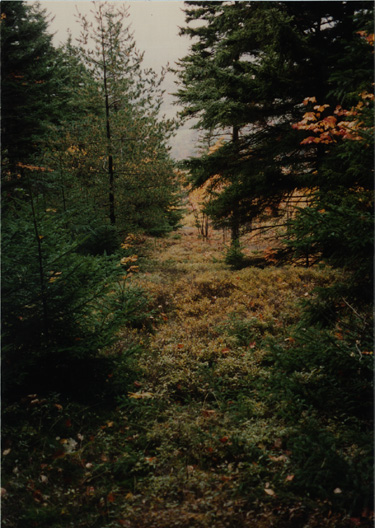
|
|
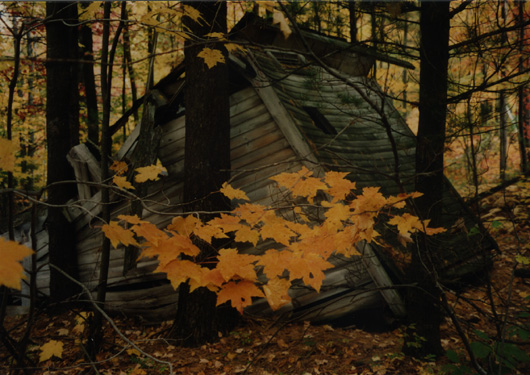
|
Remains of the warming hut. |
| Phil (on the left) and his son Jon at
the warming hut. |
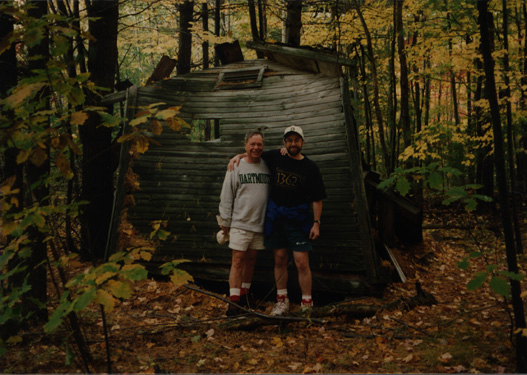 |
Ted Cooke wrote a
great article in Appalachia magazine in November of 1935. Read it below. His
predictions for the future of skiing are very interesting!
Ski Tows by
Ted Cooke
Skiing seems to be entering a new era - a time
when it will be possible to do much more skiing in a given length of time. When
we were youngsters, we would tow a sled energetically up a slippery hill only to
slide down the same course in about 1/10 the time. We outgrew this sport because
the more mature mind could not see enough pleasure measured in terms of work.
This is probably the reason more people do not ski today.
Until recent years skiing equipment was not
good enough to practice the art properly. Now, however, our equipment is
perfected for all practical purposes, and we can look for only minor
improvements in the future. It is no longer necessary for us to congregate at a
few congested places to ski. We have plenty of good trails for our present needs
and we can easily find any variety of skiing we wish. To make skiing as
enjoyable in this country in this country as it is in Europe, it will be
necessary to provide some mechanical means of gaining altitude at several
places. The funicular and the suspended cable car are not practical in New
England because they would be used only week-endsd for two or three winter
months and a few summer months. This would mean about 50 days of year of
capacity operation and would probably not warrant the investment, unless the
project were built or subsidized by some division of the Government.
The rope hoist, although it is still in the
experimental stage, has already proved its worth. Last winter several such
machines were operated on practice slopes. Skiers flocked to them knowing that
there might be a mechanical failure during the day but willing to wait many
turns in line in order that they might have the downhill run without the tedious
work and time required to climb up again. Eventually there will be many rope
hoists on practice slopes because they are easy as well as inexpensive to build,
and can be made dependable. But how many of us are going to be satisfied with a
short run over the same course time and time again. The practice slope has been
and always will be popular with the novice, but every winter sees a class
graduate from these slopes to the mountain trails.
How enjoyable our day would be if we had our
choice of two or three trails which hoists would enable us to run every quarter
or half hour? One attempt in New England to make this type of skiing available
is the Mt. Gunstock Ski Hoist 5 miles east of Laconia, NH. The construction and
operation of a long tow brings up many intricate problems which can be solved
only by experiment. Mt. Gunstock was chosen for the location because it was a
small mountain with good trail possibilities and near Boston. Also, every
mountain cannot be adapted to a ski hoist. The tow trail is of necessary
straight and must be concaved over its entire length. The brows, or places where
the rope bears down on the ground, must be cut off by digging or blasting and
the hollows must be filled or bridged so that the rope will not be over the
rider's head. It was difficult even on Mt. Gunstock to find 3100' in a straight
line that did not require a prohibitive amount of work to grade. The driving
unit is a 40 horse power gasoline engine connected by a roller chain to a gear
transmission. The driving sheave is triple grooved and can be disconnected from
the engine by a clutch. The rope is endless sliding on the snow going up and
returning down the mountain in pulleys to eliminate friction. Unfortunately hemp
rope stretches and twists. In our total of 3100 feet of rope the slack amounted
to 150 feet but this was satisfactorily taken care of by counterweights. The
twists eventually worked out, but something should be developed to take the
twists out of a new rope the first time it is run.
It is practically impossible to ride over 1000
feet without some means of gripping the rope mechanically. The handle developed
at Mt. Gunstock seems to be the answer to this problem as women and children are
able to make the trip. A great deal was learned last winter about conserving the
rider's endurance. It will be necessary before another winter comes to bring the
hoist trail to a more perfect grade, as the rope bore down heavily at several
places and it was often necessary to dodge obstacles in the trail. The summit
sheave is to be raised 12 feet so that the rope will remain in the air about
waist high for the last few hundred feet. This will relieve much of the fatigue
and assist the rider in dropping off at the summit.
The old ski trail on Mt. Gunstock is partly
third class, partly novice. It has always been popular. Last winter one of the
finest and most picturesque second class trails in NH was cut on the mountain.
Next fall a contour trail will be made from the summit frame of the hoist to the
second class trail, giving the runner practically all of the trail without any
of the uphill work. Around the mountain to the east, at about the same level as
the summit frame, is a 1200' slalom course that has not yet been fully
appreciated by the skiers. North from the hoist on the east slopes of Mt. Rowe,
one of the best ski jumps in the country is being constructed. This is a gift to
the skiers by the ERA. It is hoped that before next winter a new third class
trail will be cut to tap the present trail just about the summit frame and
descend the mountain on the north side of the hoist trail. When this is done,
Mt. Gunstock should be a skier's paradise.
If you remember this ski area and have more
info, just let us know.
Last updated: January 20, 2007
Head
back to Lost NH Ski Areas
Head
back to the Main Page





